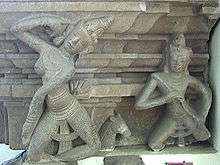Gandharva
Gandharva is a name used for distinct heavenly beings in Hinduism, Buddhism and Jainism. It is also a term for skilled singers in Indian classical music.
Hinduism

In Hinduism, the Gandharvas (Sanskrit and Hindi: गन्धर्व; Assamese: গন্ধৰ্ব্ব, gandharbba; Bengali: গন্ধর্ব, "gandharba", Kannada: ಗಂಧರ್ವ; Odia: ଗନ୍ଧର୍ବ "gandharva" ; Telugu: గంధర్వ; Tamil: கந்தர்வன், "kantharvan"; Malayalam: ഗന്ധർവ്വൻ, "gandharvan") are male nature spirits and husbands of the Apsaras. Some are part animal, usually a bird or horse. They have superb musical skills. They guard the Soma and play beautiful music for the gods in their palaces. Gandharvas are frequently depicted as singers in the court of the gods.
Gandharvas in the historic sense acted as messengers between the gods and humans. In Hindu law, a gandharva marriage is one contracted by mutual consent and without formal rituals.
Gandharvas are mentioned extensively in the epic Mahabharata as associated with the Devas (as dancers and singers) and with the Yakshas, as formidable warriors. They are mentioned as spread across various territories.
Buddhism
.jpg)
A Gandharva (Sanskrit; Pali: Gandhabba; Chinese: 乾闼婆; pinyin: Gān tà pó; Japanese: 乾闥婆; rōmaji: Kendatsuba; Korean: 간다르바; romaja: Gandareuba; Vietnamese: Càn Thát Bà) is one of the lowest-ranking Devas in Buddhist cosmology. They are classed among the Cāturmahārājakāyika Devas, and are subject to the Great King Dhṛtarāṣṭra, Guardian of the East. Beings are reborn among the Gandharvas as a consequence of having practiced the most basic form of ethics (Janavasabha Sutta, DN.18). Gandharvas can fly through the air, and are known for their skill as musicians. They are connected with trees and flowers, and are described as dwelling in the scents of bark, sap, and blossoms. They are among the beings of the wilderness that might disturb a monk meditating alone.
The terms gandharva and yakṣa sometimes refer to the same entity. Yakṣa in these cases is the more general term, including a variety of lower deities.
Intermediate Rebirth
In the Mahātaṇhāsankhaya Sutta of the Majjhima Nikāya, the Buddha explains to the bhikkhus that an embryo develops when three conditions are met: the woman must be in the correct point of her menstrual cycle, the woman and man must have sexual intercourse, and a gandhabba must be present. According to the commentary of this sutta, the use the word gandhabba doesn't refer to a celestial Deva, but a being enabled to be born by its karma. It is the state of a sentient being between rebirths. [3]
Notable Gandharvas
Among the notable Gandharvas mentioned (in DN.20 and DN.32) are Panāda, Opamañña, Nala, Cittasena, Mātali, and Janesabha. The last in this list is thought to be synonymous with Janavasabha, a rebirth of King Bimbisāra of Magadha. Mātali is the charioteer of Śakra.
Timbarū is a chieftain of the Gandharvas. There is a romantic story told about the love between his daughter Bhaddā Suriyavacchasā (Sanskrit: Bhadrā Sūryavarcasā) and another Gandharva, Pañcasikha (Sanskrit: Pañcaśikha). Pañcasikha fell in love with Suriyavacchasā when he saw her dancing before Śakra, but she was then in love with Mātali's son Sikhandī (or Sikhaddi). Pañcasikha went to Timbarū's home and played a melody on his flute of beluva-wood, with which he had great skill, and sang a love song in which he interwove themes about the Buddha and the Arhats.
Śakra petitioned Pañcasikha to intercede with the Buddha so that he might have an audience with him. As a reward for Pañcasikha's services, Śakra was able to get Suriyavacchasā, already pleased with Pañcasikha's display of skill and devotion, to agree to marry Pañcasikha.
Pañcasikha also acts as a messenger for the Four Heavenly Kings, conveying news from them to Mātali, the latter representing Śakra and the Trāyastriṃśa Devas.
Jainism
In Jainism, Gandharvas are classed among the eight Vyantara Devas.
The Tiloyapaṇṇatti provides a list of ten Gandharvas:
- Hāhā
- Huhū
- Nārada
- Tumbara
- Vāsava
- Kadamba
- Mahāsvara
- Gītarati
- Gītarasa
- Vajravān
The Saṃgrahaṇī Sūtra of the Śvetāmbara sect provides a slightly different list:
- Hāhā
- Huhū
- Tumburu
- Nārada
- Ṛṣivādika
- Bhūtavādika
- Kadamba
- Mahākadamba
- Raivata
- Viśvāvasu
- Gītarati
- Gītayaśas
The Digambara sect describes the Gandharvas as having a golden complexion while the Śvetāmbara tradition recognizes them as blackish. The Tumbaru is their sacred tree.[4]
In Indian classical music
There are many singers known as gandharvas for their mastery of Indian classical music. All of them, at one time or another, were theater actors who performed in various musicals. Their style of music is known as Kula Sangeet in Marathi, literally "hereditary music". They are regarded as masters of Indian classical music by the vast majority of the general population, predominantly in the state of Maharashtra.
See also
- List of Gandharvas
- Chitrasena
- Tumburu
- Kabandha
- Gandharva marriage
- Fairy
- Sylph
References
- Singh, Upinder (2008). A History of Ancient and Early Medieval India: From the Stone Age to the 12th Century. Pearson Education India. p. 435. ISBN 978-81-317-1120-0.
- A Sanskrit-English dictionary: etymologically and philologically arranged, by Sir Monier Monier-Williams. Retrieved 2012-12-19 – via Google Books.
- Thanissaro Bhikkhu (30 November 2013). "The Greater Craving-Destruction Discourse (MN 38)". Access to Insight (BCBS Edition). Retrieved 14 October 2017.
- Shah, Umakant Premanand (1987). Jaina-Rūpa-Maṇḍana, Volume 1. Abhinav Publications. ISBN 9788170172086.
